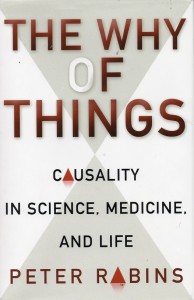Book Review: The Why of Things: Causality in Science, Medicine, and Life by Peter Rabins
Disclaimer: I received this book as a Goodreads giveaway on the premise that I would review it.
The author of this book is a professor of Geriatric Psychiatry at Johns Hopkins University, and it started as a clinical teaching presentation. Patients often ask “why did this happen to me?” In attempting to answer that question, and so many more, the overall concept of causality becomes a subject.
The book makes two presumptions for the sake of discussing the subject, first, that causality exists, and second, that time moves in only one direction. The latter may be disprovable should the speed of light ever be broken, but at the moment, it’s a reasonable assumption.
The model of causality presented in this book has three facets: causal models, levels and logics. In order to correctly use this model, one must decide which part of each facet to apply to the problem at hand. Empirical logic, for example (aka the scientific method) is often the best choice of method for looking at causality in the physical sciences, while empathic logic (a coherent narrative) might serve better to examine historical causation.
After examining each facet in detail, Mr. Rabins then demonstrates how this model can be used to examine such topics as Alzheimer’s and the problem of violence.
There are extensive references, and an index. The only illustrations are the facets, repeated through the book with different emphases.
This is graduate-level material, and pretty thick going. It would be useful to students in scientific, medical or history majors, as well as relevant to classes in logic or statistics. Fiction writers, especially in the field of science fiction, may also find it useful when writing the thought processes of scientist characters.

